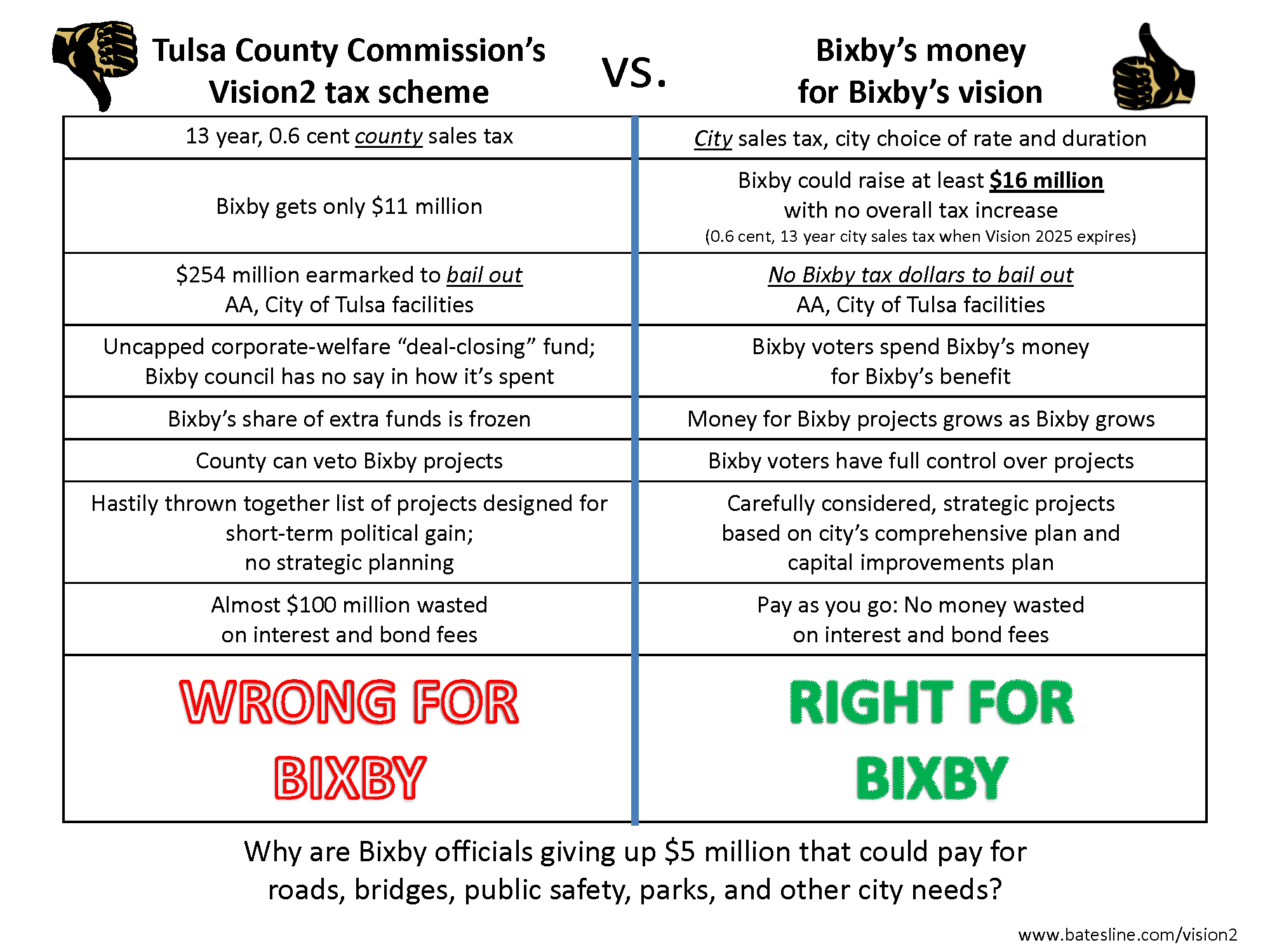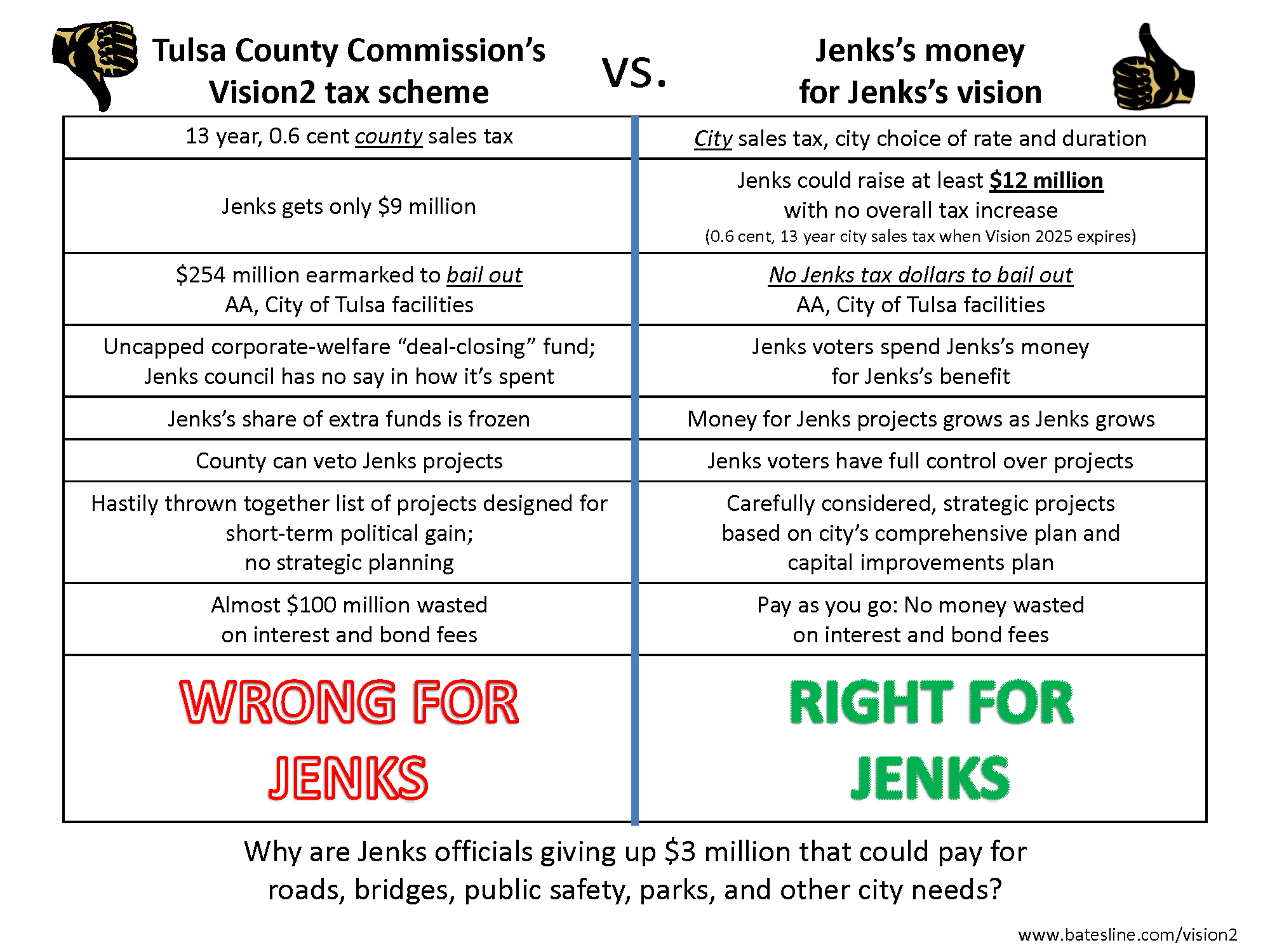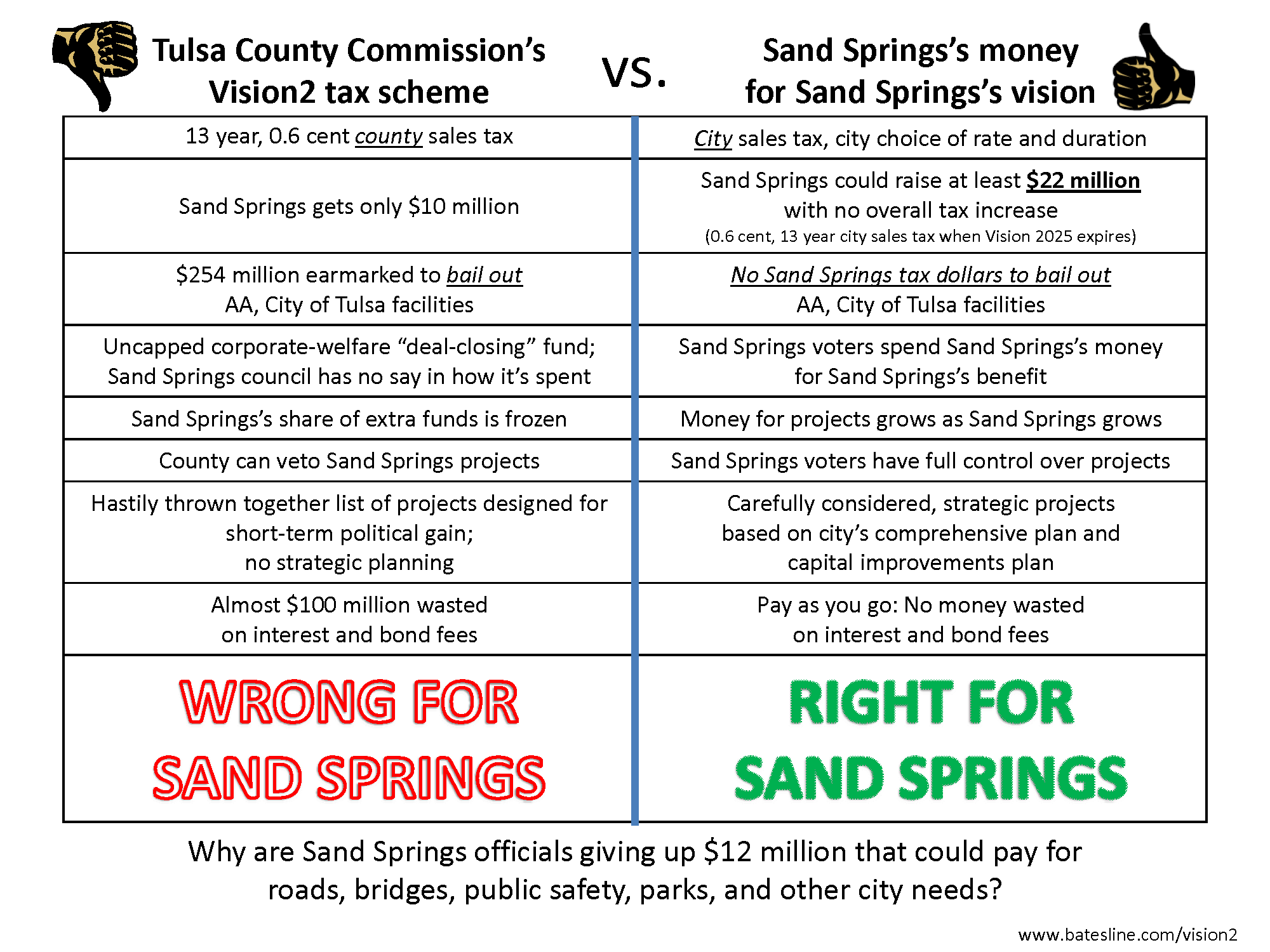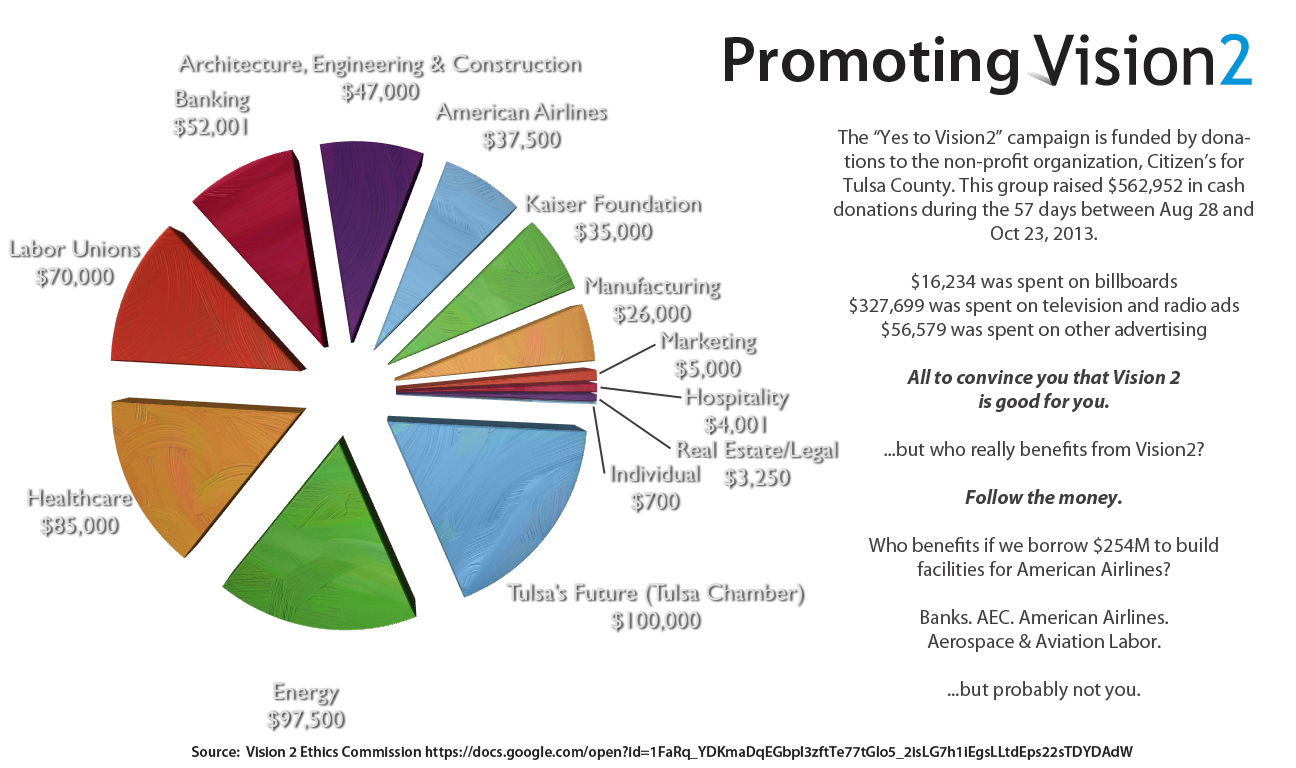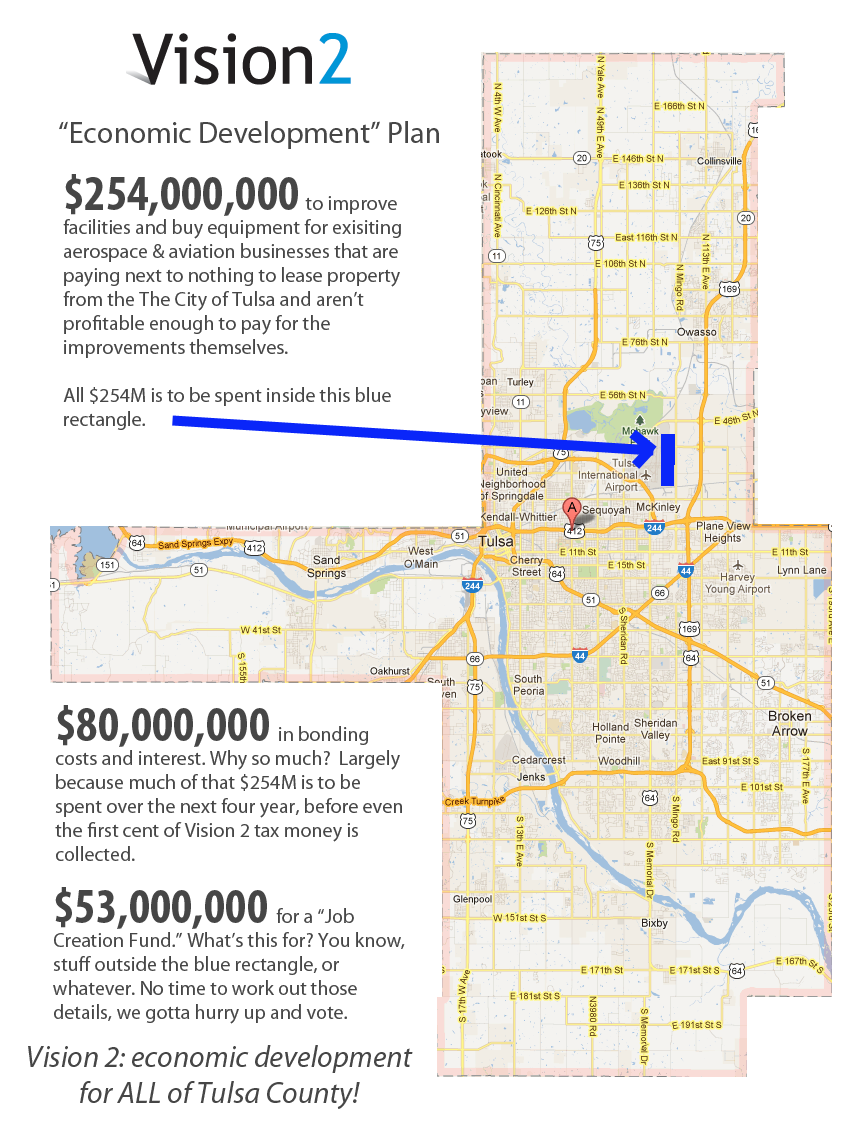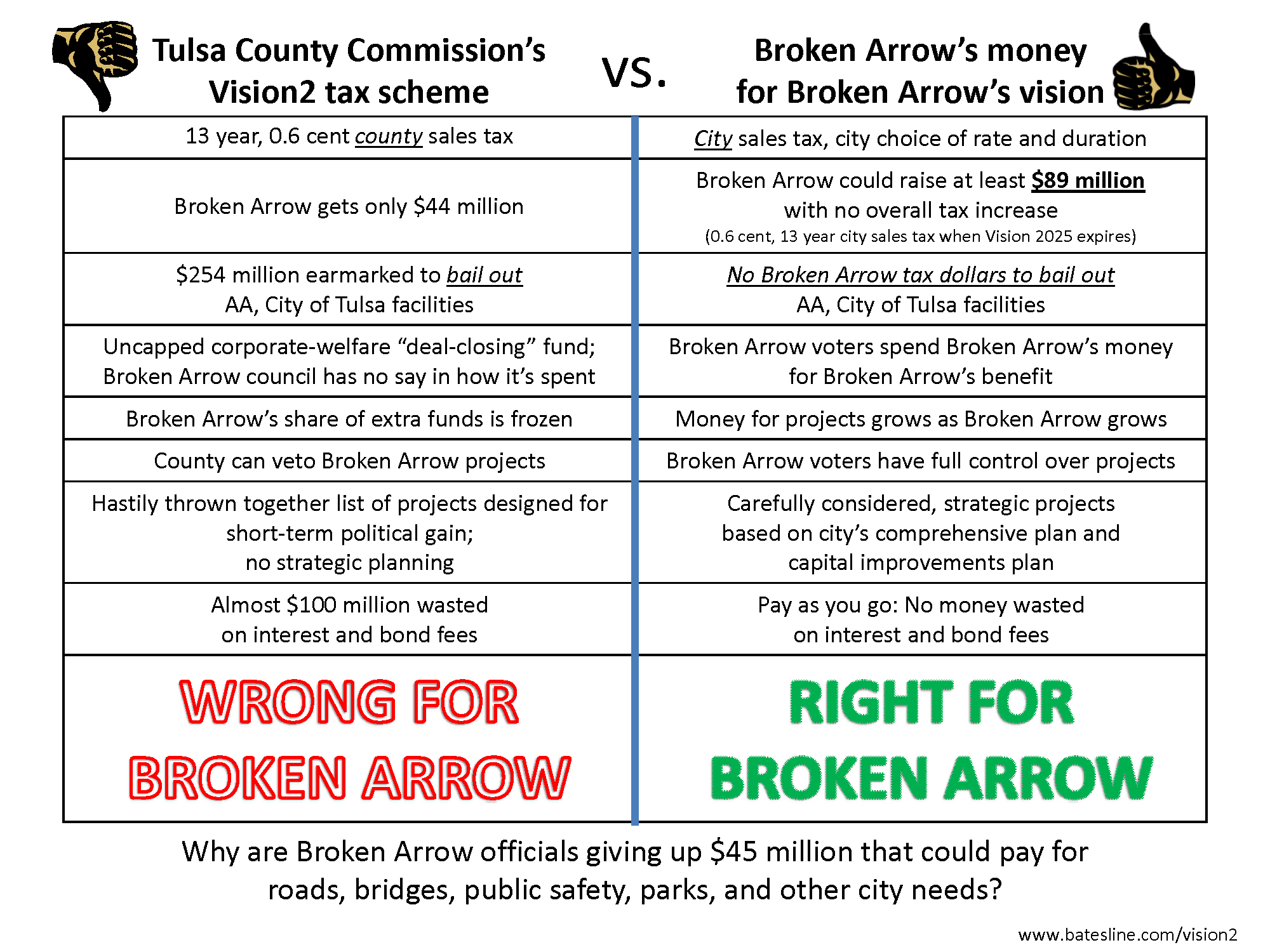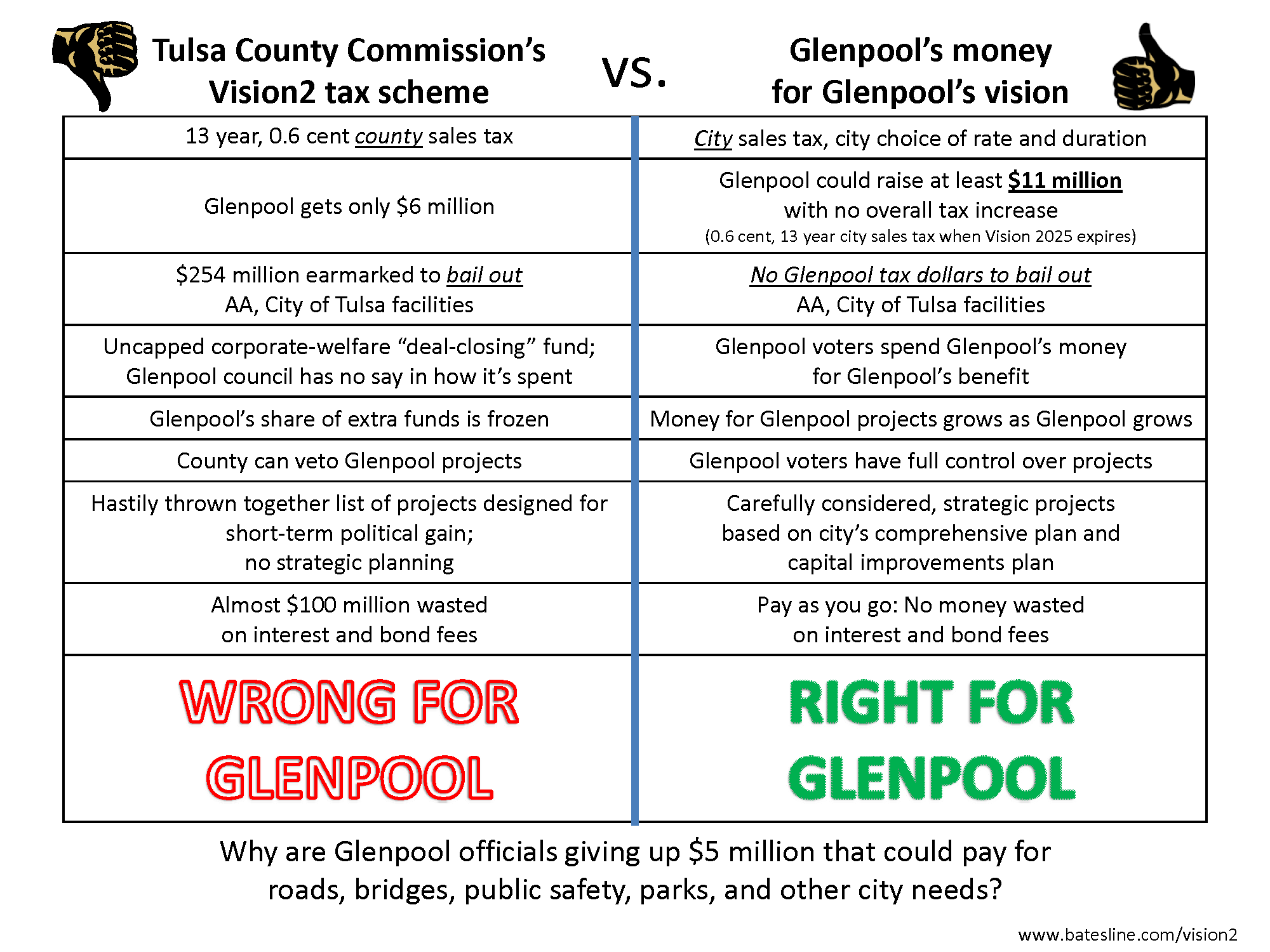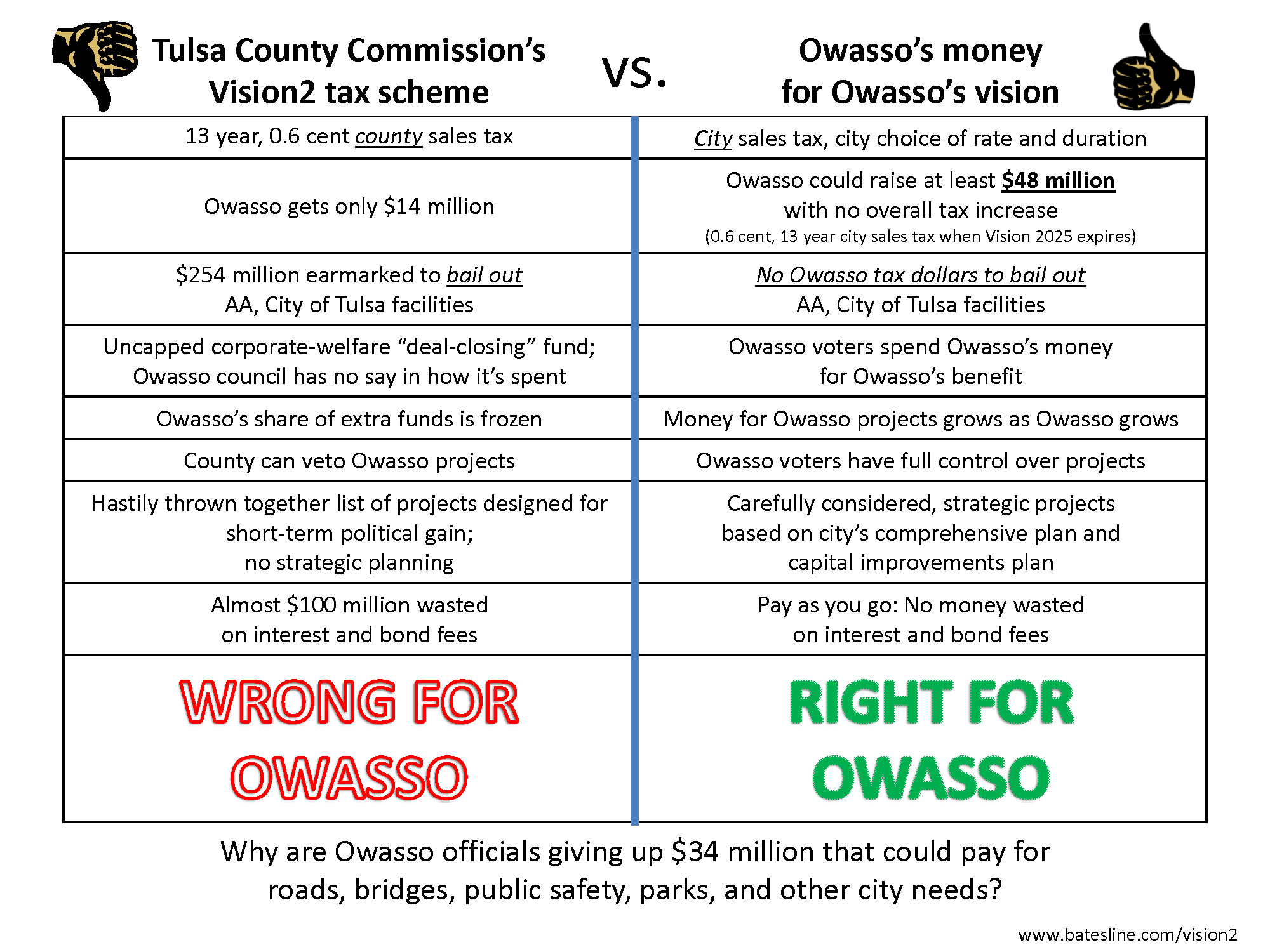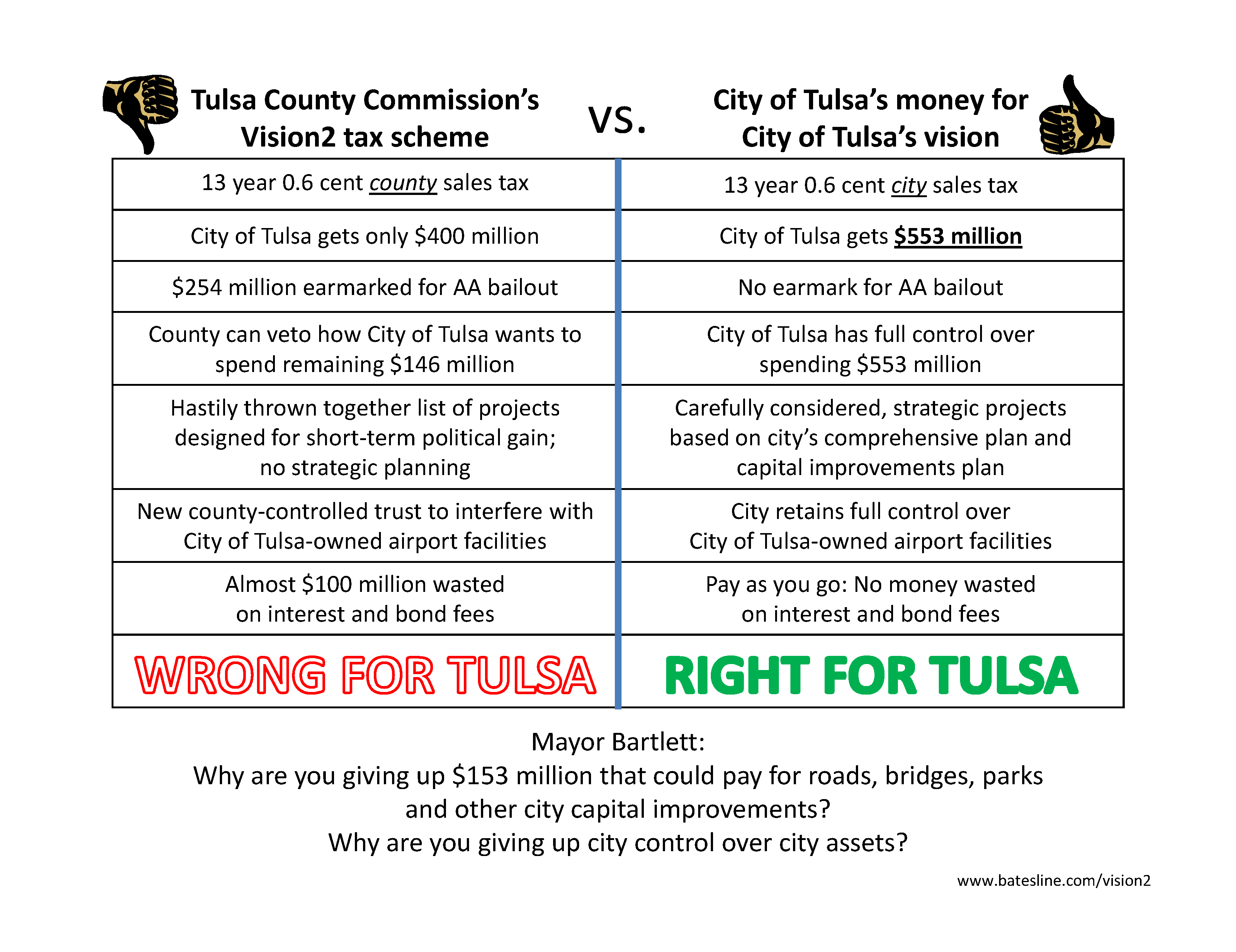Tulsa Vision2: October 2012 Archives
Here's my second installment of fliers explaining why Vision2 hurts Tulsa County's municipalities and how these cities would be better off enacting a city sales tax to replace the Vision 2025 county sales tax when it expires on the last day of 2016. Specifically, this time, here's a better alternative to Vision2 for Bixby, Jenks, and Sand Springs. (Click here for fliers with a better vision for Broken Arrow, Glenpool, and Owasso.)
You'll notice that most of the reasons are the same from city to city. The key difference is in the money each city would get from Vision2 vs. how much they would get from a city tax of the same rate and duration. This tax would go into effect as soon as Vision 2025 expires, so that the overall sales tax rate wouldn't change.
The Vision2 amounts for each city are those that the proponents have publicized. The estimate of money that could be raised by a city sales tax of the same rate and duration is based on each city's sales tax receipts for the 12 months from October 2011 through September 2012. (One year's sales tax receipts / sales tax rate * 0.6% * 13 years.) I've rounded all numbers to the nearest million.
One of the big drawbacks of Vision2 for a growing suburb is that its percentage of the Vision2 Prop 2 tax receipts is frozen in time, based on its share of county population in 2010, no matter how much they grow in population and retail sales. By contrast, a city sales tax would grow as the city grows.
The contrast between a city's own vision and the Tulsa County Vision2 tax is most dramatic for Sand Springs, which could raise twice as much with a city tax to replace Vision 2025 than it will get from Vision2.
Click each image to download a corresponding ready-for-printing PDF. Opponents of Vision2 are welcome to copy and hand these out as long as you don't change it at all.
All images Copyright 2012 by Michael D. Bates. Limited license granted to opponents of Vision2 to copy and distribute without alteration prior to November 7, 2012.
I was interviewed midday Tuesday by Fox 23's Ian Silver about the fundraising gap between the proponents and opponents of Vision2.
The "vote yes" bunch reports donations of $562,952, and only $450 in contributions of $200 or less.
The opposition group Citizens for a Better Vision has had monetary contributions of $3,859.69, of which only $2,459.69 was in amounts of $200 or less, and has spent $2,977.44, mainly on signs and bumper stickers. Individuals have independently and directly spent money on things like buttons and Facebook ads. (For example, I paid for color copies of my "Better Vision for Tulsa" handout, so I could have something to distribute at the Leadership Tulsa luncheon.) Even with these independent expenditures, opposition spending that we know of is about $10,000.
A ratio of at least 50:1 is not at all surprising. Giving on previous tax proposals has been similarly lopsided. It can be explained by public choice theory -- concentrated benefits vs. diffuse costs. Those businesses who stand to make millions, perhaps hundreds of millions, of dollars if this tax passes have a strong incentive to invest tens of thousands of their own dollars in convincing the public to approve it. Because the tax is broad-based, there's no concentrated benefit if the tax fails, so no one has the same financial incentive to give tens of thousands of dollars to the "vote no" campaign. As I told Fox23's Silver:
The opposition, he said, is made up mostly of individuals digging into their own pockets, and using social media to spread the word."It's all grassroots," he said. "It's all individuals digging into their own savings, their own fun money to do something they think is important for the community."
Matt Galloway has put together a very helpful pie chart, grouping contributions to the Vision2 "vote yes" campaign by industry (click to embiggen):
The Fox23 report was well done, but I need to correct a couple of things:
The story makes a reference to the "Vision 2025 bond package." It may be a losing battle to insist upon the distinction between sales tax votes and general obligation bond issue votes, but "here I stand; I can do no other." The Vision 2025 election was a collection of four sales taxes, one of which never went into effect. The other three sales taxes, totaling 0.6%, went into effect on January 1, 2004, and will run until December 31, 2016. The Tulsa County Commission assigned the revenue stream to the Tulsa County Industrial Authority, then they put on their TCIA hats and borrowed money against these expected sales tax revenues by issuing revenue bonds, but the voters didn't directly vote to issue bonds. "Bond package" or "bond issue," in reference to an election, should be reserved to refer to "general obligation bond issues," in which voters authorize borrowing money for a specific project (bonds) to be repaid by an increase in property tax millage (the general obligation).
Silver says in the story:
Businesses like Bank of Oklahoma and Manhattan Construction Co. could make a lot of money off Vision2 projects, but the county will have to put all contracts for Vision2 projects out to bid. The county can't just award contracts to companies that donated the most.
If the Tulsa County Board of Commissioners are under such a restriction, there are ways around it. The Tulsa County Industrial Authority (whose board members are the three county commissioners) can waive competitive bidding on bond underwriting with the approval of two of the three commissioners. About a month after Vision 2025 was approved by the voters, the TCIA board granted sole-source contracts to two financial companies to handle bond underwriting, two law firms to provide bond attorney services, and the company that would handle program management for the tax package. Professional services, as I understand it, are also exempt from competitive bidding. (Can't find the reference right now.) And with the appropriate findings of an emergency, competitive bidding may even be waived on construction projects.
A reader writes to tell me about a pro-Vision2 ad that ran on KOTV during the 5:30 pm Sunday newscast. The ad features County Commissioner Karen Keith and Tulsa County Sheriff Stanley Glanz. Glanz has been re-elected without opposition to a seventh four-year term as sheriff.
Oklahoma has an anti-electioneering ethics rule, 257:10-1-3 (b), which states: "A person shall not use or authorize the use of public funds, property, or time to produce, print, publish, broadcast, or otherwise disseminate material designed or timed to influence the results of an election for state office or a ballot measure, except political activities or statements inherent to or part of the function of a candidate or an elected officer or the performance of a state officer's or state employee's duties or as allowed by law, regardless of the lack of specific reference to election."
Glanz's uniform is public property and using the uniform in a campaign commercial would seem to qualify as using public property to produce material designed to influence the results of an election for a ballot measure. On the other hand, it could be argued that the rule above applies only to state officials and state ballot measures. On the other, other hand, it could be argued that counties are political subdivisions of the state and any rule applying to state officials flows down to officers of Oklahoma's political subdivisions.
In any event, Glanz would do well not to lend the prestige of his office and uniform to a losing campaign. Perhaps he can explain to us why the 4 to Fix the County 2 funds allocated to upgrade the juvenile justice facility were never used for that purpose, and why the new proposal is 15 times more expensive than the original proposal.
MORE: The ethics rule came to light recently when John Miley, an attorney to a state agency and the husband of an Oklahoma State Supreme Court justice, used a state computer to send email urging his wife's retention in the November 6 election.
I've been negligent. I did tweet about this brilliant video by Steven Roemerman, but had yet to post it here. Steven tried to call all three Tulsa County commissioners to invite them to speak to a neighborhood meeting on January 2, 2017, the day after the Vision2 tax will go into effect. He spoke to Fred Perry's assistant and to Commissioner Karen Keith.
Best quote goes to Commissioner Keith: "I think you better call back closer to that date, make sure I'm still alive."
So this tax that we'll be voting on in eight days was put on the ballot by one commissioner who will have been out of office for two years when the tax goes into effect and another commissioner who isn't sure if she'll survive until then.
NOTE: I'll be talking about Vision2 in studio with Pat Campbell and company on 1170 KFAQ, starting at 7:05 a.m. -- Monday morning, October 29, 2012.
On Saturday afternoon, I spoke at the invitation of the Tulsa Community Business Group, an organization that meets monthly to encourage the development of small businesses. During the first part of the program, we heard two small business owners tell their inspiring stories.
Don Walker, president of the Tulsa Metro Chamber, was there to speak in support of Tulsa County's Vision2 sales tax scheme; I was there to represent the opposition. We each had opportunity to speak, followed by Q&A with the audience.
Much of Walker's comments were devoted to defending Proposition 1, with its $214 million earmarked for buildings and equipment to be used by American Airlines and another $40 million for facilities that Spirit Aerosystems and IC Bus are contractually obliged to maintain, specifically including major upgrades and maintenance. (Walker made the odd claim that a different lease puts that same obligation on the City of Tulsa -- if I heard him right. Don't both parties to a contract sign the same contract?)
Prop 1 also includes an uncapped "deal closing" fund -- 70% of the revenues for the fund will be generated within the City of Tulsa, but Tulsa will only have one vote of seven on how it gets spent.
The most striking thing that Walker said was right at the end, and I wasn't given a chance to respond. He said he believes the "Tulsa economy is still somewhat fragile in this current election year and in the marketplace, and I believe it is imperative to send a signal to the aerospace industry that Tulsa is a place to do business."
Had I had the chance to respond, I would have pointed out that Walker is asking us to put the weight of a quarter of a billion dollars on that most fragile part of our economy. If we want to make our economy more resilient, more resistant to catastrophe, we should be diversifying our investments. We should be hedging our bets, not doubling down on the most risky bet.
Matt Galloway has put together a dramatic graphic showing how the revenues from Vision2 Proposition 1 would be spent for "economic development." (Click the thumbnail to view full size.)
It reminds me, of course, of a Texas Playboys song. The 1946-1947 Tiffany Transcriptions featured Bob Wills and his band performing popular tunes from a wide variety of genres, including this Irving Berlin number, sung by vocalist Tommy Duncan:
I'm putting all my eggs in one basket.
I'm betting everything I've got on you.
I'm giving all my love to one baby.
Lord help me if my baby don't come through.
Love, marriage, and faith may be the only realms in which all your eggs in one basket is a wise strategy. As GoEnglish.com explains for the benefit of non-native English speakers: "To 'put all your eggs in one basket' is to risk losing everything all at one time."
We're being asked to borrow $214 million now in hopes of keeping a company that is bankrupt, that may not emerge from bankruptcy, that has already cut over 1,000 positions in Tulsa and is likely to cut more, that may go out out of business before we begin generating the tax revenue to pay back the loans.
Tulsa would be far better off with 100 businesses with 70 employees each, in a variety of industries, than one vulnerable business in a shaky industry with 7,000 employees. The money for Prop 1 would be better left in the free market. As a capitalist, I believe that the free market is the most efficient, sustainable, and fair way to allocate capital. If government wants to help, it should get rid of senseless regulations that add to the start-up cost burden of new businesses.
MORE: I couldn't find Tommy Duncan singing this song, but here's Fred Astaire and Ginger Rogers singing and dancing to "I'm Putting All My Eggs in One Basket" in the movie Follow the Fleet.
STILL MORE:
Remember that Vision 2025's massive Boeing incentives were a separate ballot item (Prop 1), and had the proviso that the 0.4 cent sales tax would never be collected if Boeing put their 787 plant somewhere else. They did and the tax wasn't collected. The $22.3 million for American Airlines was also a separate ballot item: Vision 2025 Prop 2.
Vision2 is different: All the economic development proposals are lumped into one ballot item. (If Commissioners Smaligo and Perry are all about giving the voters the chance to decide, why didn't they let us decide on whether to help AA separately from a decision on the deal closing fund?)
County officials have been saying that they would demand that American Airlines, Spirit Aerosystems, and IC Bus sign commitments to the county before the county trust would release funds to assist them. Of course, AA is in no position, in the midst of bankruptcy, to make any commitments. They must have flexibility to restructure in hopes of future profitability.
So what would happen if these three companies refuse to agree to the county trust's terms? Based on the ballot language, the tax would still be collected in full. The airport projects are capped at a maximum value, but there's no commitment to a minimum value. Any money not spent on airport projects or debt service would go into the "deal closing" fund. It may well be that all of Prop 1 winds up being a funding source for the "deal closing" fund.
This morning (Saturday, October 27, 2012) from 10:00 a.m. to 2:00 p.m. there's a "Save the Republic" rally at LaFortune Park, featuring Tea Party activists and candidates, including 1st congressional district Republican nominee Jim Bridenstine. Citizens for a Better Vision will be there with yard signs and bumper stickers and will be happy to accept your contribution to pay for more ways to get the truth about Vision2 out to the voters. (My suggestion: Show up at the beginning of the rally, get your signs, stay for a few speeches, then drive a mile and a half west to get your walking or phoning assignment. Spending all day standing and listening to speeches is likely to be cold and won't do as much to save the republic as knocking doors or making calls for a candidate.)
Then from 2 - 4 p.m. I'll be down at Aaronson Auditorium, Central Library downtown, as one of the speakers at a community forum there, speaking in opposition to Vision2.
Both candidates in the closely contested Oklahoma Senate District 39 race have taken a position on Vision2. Incumbent Brian Crain enthusiastically supports the Tulsa County 13-year, 0.6 cent tax scheme; challenger Julie Hall has expressed skepticism about the plan and the hasty, opaque process that produced it.
Sen. Brian Crain issued a press release in support of Vision2 shortly after the Tulsa County Republican Party County Committee voted to oppose the tax plan and to censure the two Republicans on the Tulsa County Commission for putting it on the ballot.
"Tulsa County has an historic opportunity to secure the future of our area, both economically and in quality of life, by assuring our status as a center of aerospace maintenance. Not since the Spavinaw Lake project of the 1920s has a public investment in Tulsa County's future of this importance been submitted to a vote of the people." Crain continued by stating, "By their action, Commissioners Smaligo and Perry have proven to be strong and far-sighted stewards of our assets and resources."
Julie Hall, Crain's Democratic challenger, wrote the following comment on Facebook in reference to my comment about some Democratic officials support for "corporate welfare funded by a regressive tax":
I don't know that you can call it corporate welfare since we have no guarantees it will keep jobs in Tulsa. It may just be a boondoggle. I also don't believe it is as simple as whether Tulsans want progress - of course, we do. This process has lacked the public involvement and transparency we deserve before authorizing the expenditure of millions of dollars. We have time for a thoughtful, strategic plan. If it is worth doing....
I've started to put together a series of fliers explaining why Vision2 hurts Tulsa County's municipalities and how these cities would be better off enacting a city sales tax to replace the Vision 2025 county sales tax when it expires on the last day of 2016. Here are the first three, for Broken Arrow, Glenpool, and Owasso.
You'll notice that most of the reasons are the same from city to city. The key difference is in the money each city would get from Vision2 vs. how much they would get from a city tax of the same rate and duration. This tax would go into effect as soon as Vision 2025 expires, so that the overall sales tax rate wouldn't change.
The Vision2 amounts for each city are those that the proponents have publicized. The estimate of money that could be raised by a city sales tax of the same rate and duration is based on each city's sales tax receipts for the 12 months from October 2011 through September 2012. (One year's sales tax receipts / sales tax rate * 0.6% * 13 years.) I've rounded all numbers to the nearest million.
One of the big drawbacks of Vision2 for a growing suburb is that its percentage of the Vision2 Prop 2 tax receipts is frozen in time, based on its share of county population in 2010, no matter how much they grow in population and retail sales. By contrast, a city sales tax would grow as the city grows.
Click each image to download a corresponding ready-for-printing PDF. Opponents of Vision2 are welcome to copy and hand these out as long as you don't change it at all.
All images Copyright 2012 by Michael D. Bates. Limited license granted to opponents of Vision2 to copy and distribute without alteration prior to November 7, 2012.
I'm sure Mitt Romney is too busy with his own campaign to pay attention to a sales tax election Tulsa County, Oklahoma, but several of the Republican presidential nominee's comments about government and business in tonight's third debate suggest he wouldn't support Vision2, the Tulsa County sales tax scheme on the November 6, 2012, ballot, particularly Proposition 1, which would spend over $200 million on building infrastructure and custom equipment to help American Airlines, another $40 million to help IC Bus and Spirit Aerosystems, and create an uncapped "deal closing" fund (at least $52 million, probably closer to $200 million) in which three county commissioners, three suburban mayors of their choosing, and the Mayor of Tulsa would pick companies to benefit from the fund.
Well, first of all, it's not government that makes business successful. It's not government investments that make businesses grow and hire people....
But the president mentioned the auto industry and that somehow I would be in favor of jobs being elsewhere. Nothing could be further from the truth. I'm a son of Detroit. I was born in Detroit. My dad was head of a car company. I like American cars. And I would do nothing to hurt the U.S. auto industry. My plan to get the industry on its feet when it was in real trouble was not to start writing checks. It was President Bush that wrote the first checks. I disagree with that....
We in this country can compete successfully with anyone in the world. And we're going to. We're going to have to have a president, however, that doesn't think that somehow the government investing in -- in car companies like Tesla and -- and Fisker, making electric battery cars -- this is not research, Mr. President. These are the government investing in companies, investing in Solyndra. This is a company. This isn't basic research. I -- I want to invest in research. Research is great. Providing funding to universities and think tanks -- great. But investing in companies? Absolutely not. That's the wrong way to go.
And that -- and that's why it's so critical that we make America once again the most attractive place in the world to start businesses, to build jobs, to grow the economy....
By the way, I'm speaking at the Tulsa Republican Club luncheon today about Vision2. It's at the Summit Club, 30th floor of the Bank of America Building, 15 W. 16th St. Buffet lunch ($20) served starting at 11:30, program begins at 12 noon. You can join the club for $25 annual dues.
American Airlines is outsourcing its Boeing 777 maintenance to Hong Kong. They're bringing the 767 maintenance to Tulsa. Boeing will maintain AA's new 737s and 787s, and another US company will maintain the 757s.
About these Wichita Industrial Revenue Bonds: They're loans that the benefiting business has to pay back, not grants paid by sales tax or property tax revenue. The business gets cheaper money, because earnings on municipal bonds are tax-exempt.
The issuer is a passive conduit whose role is essentially to lend its status as a municipal corporation to the transaction - no obligation to pay bondholders; no credit enhancement.
It's structured differently, but Tulsa County Industrial Authority (a trust with the three county commissioners as trustees) does the same sort of thing; they call it conduit debt. I'm still learning about IRBs, but it appears that Kansas laws also allow cities to grant IRB recipients certain tax exemptions as well. But no, Wichita is not using sales tax revenues to purchase equipment for a major employer as Tulsa County wants to do. It's just that the Wichita Eagle reports on these deals, while the Tulsa World ignores them, for the most part.
(Bob Weeks of WichitaLiberty.org can tell you all you might want to know about Wichita's various economic development incentives and their frequent abuse.)
If the Tulsa World insists on referring to Tea Party organizer and Citizens for a Better Vision leader Ronda Vuillemont-Smith as a failed candidate for office, shouldn't the World always put "part owner and promoter of a failed airline" on the masthead after its own name? Why should anyone listen to the economic development advice of anyone who thought taxpayer funding for Great Plains Airlines was a good idea?
And regarding the City of Tulsa's hastily assembled Vision2 list:
Did you know that the City of Tulsa's list of Vision2 projects could change?
The following public projects may be assigned the following sums....
Our family loves our local library system. I'm happy they have a recession-proof funding source. But the Tulsa City-County Library has over $24 million in an investment fund (as of July 31, 2012), and half of that amount is "designated for the Central Library project, the remainder for building systems replacements." The Tulsa Library has a dedicated property tax that brought in $26,070,310.69 during Fiscal Year 2011-2012. Thanks to the 5% valuation escalator, taxable values are still climbing despite a downturn in market values, so library revenues are doing well, too. So why is the City of Tulsa planning to give the library system another $10 million out of our precious and limited city sales tax dollars? Just so they know we love them?
In 2005, Tulsa citizens approved a general obligation bond issue (funded by property tax) which included $18 million for a new Fire Department regional training facility (see p. 6-4), to be located on the North Campus of TCC. "The College, who will be a joint operator of the facility, will provide area Fire Departments training related to fire fighting, hazardous incident response, emergency life support and security incident response." TCC also has a dedicated and ample source of property tax revenue. So why did the City Council vote to allocate another $7 million of precious and limited city sales tax funds for a project we already paid for back in 2005?
Will the identical $4.3 million each for the OU/TU Medical School, OSU-Tulsa, and Langston U. actually be sufficient to pay for a project to be completed, or are these just little gratuities to let each of them know we really, really, really appreciate them? Should ORU feel offended for being left out?
Is it just me or are there several Vision2 items that resemble buying a spoiled child a present so he won't pitch a fit at his sister's birthday party?
Many thanks to KJRH Channel 2 (Cox Cable 9) for a well-balanced story on Vision2 today. I spent a couple of hours with Citizens for a Better Vision, the organized opposition group to Vision2, out on 51st Street where people could pick-up signs, buttons, and bumper stickers.
While I was there a KJRH cameraman came out to get some video for a news story that ran this evening, and he talked to me for a few minutes, part of a story on the efforts of the "vote yes" and "vote no" campaigns. The result was a well-balanced and accurate story, and I commend the KJRH news team for their good work: "Vision2 vote nears, both sides step up campaign efforts." I thought they did a good job of picking out quotes that represented the two campaigns.
Michael Bates is a blogger and a staunch opponent of the tax plan."It doesn't make sense for us to commit money that we don't begin collecting for four years and to spend almost $100 million just on interest to carry debt for 17 years," said Bates, who believes much of Vision2 amounts to corporate welfare.
Bates said he believes Vision2 was put on the ballot too quickly.
"The Vision2 plan is too rushed, too soon, and too sloppy the way it was put together," said Bates....
For his part, Bates believes it would be a better idea for cities to pass a six-tenth sales tax to replace the current Vision 2025 tax when it expires. He said the cities would be able to spend the money on whatever projects they think are necessary, without a say from the county.
"The city of Tulsa, for example, would raise $150 million more than we get from the Vision2 program," said Bates.
I made it clear that I wasn't speaking for all opponents of Vision2, and notice that KJRH was careful to qualify that statement with "For his part." They did a good job of summarizing my alternative proposal.
According to county employee Michael Willis, however, no one in the opposition has submitted anything better than his bosses' scheme.
"They've not participated in public input meetings. You have two different kinds of people in that campaign --people who are promoting themselves for individual public office and the people who are always on the 'no' side of just about every issue," said Willis.
Several opponents did go to public input meetings. I spoke at the meeting where the Tulsa City Council voted on how Tulsa's tiny cut of the funds would be allocated. But it's true that opponents did not line up demanding money for our pet causes. We wanted more than a slight rearrangement of the distribution of the $750 million. We disagree with fundamental aspects of the Vision2 county tax scheme that were set in stone before the public meetings were held.
Perhaps, from Willis's perspective, my proposal isn't worth considering because it doesn't include corporate welfare for a bankrupt airline that may well not exist by the time we begin paying back the money we borrowed to bail them out. Maybe he dislikes my plan's lack of an uncapped corporate welfare fund under the guidance of the same folks who gave us Great Plains Airlines. Maybe it's no good because it doesn't let the county's favored bond underwriters, bond attorneys, and program management contractors "wet their beaks." Maybe my idea is lousy because it cuts his bosses, the county commissioners, out of the decision-making process.
The vitriol from the "Vote Yes" side is disappointing, particularly coming from a Republican. You'd hope a Republican would see the inefficiency in passing tax dollars destined to be used by city governments through county government. You'd hope a Republican would have qualms about incurring debt that we'll still be paying off when my 6-year-old son is working on his doctorate.
And of course, Willis is wrong to believe that only opponents of past tax plans are opposed to Vision2. Many supporters of Vision 2025 and the River Tax are among the most vocal opponents of Vision2. For example, see recent Urban Tulsa Weekly columns by Ray Pearcey and Bill Leighty, and the statements of opposition from TulsaNow and former Tulsa Councilor Bill Christiansen, who served on the committee that put together the Vision 2025 package.
Here's a direct link to a one-page PDF that explains my alternative to Vision2 and why it's a better vision for Tulsa. (It's a better vision for Broken Arrow and other cities and towns, too.)
MORE: Tulsa County GOP chairman J. B. Alexander called my attention to this story about the Poway, California, school district which is borrowing $105 million for a total cost of $1 billion, because they don't begin paying on principal or interest for 20 years and won't finish paying it back for 40 years.
The bonds are a "kick the can" move to avoid dinging taxpayers now with higher property taxes.Oh, and the bonds are not callable -- they can't be paid off early or refinanced.
School administrators appear to have looked around at the sluggish economy and property tax revenues and figured, 'Heck, why not defer now and pay nothing at all for decades? We'll be dead by then.'"...
The underwriters for the nearly $1 billion Poway bond deal, Stone & Youngberg, a unit of Stifel Nicolaus, and financial advisor Dolinka Group of Irvine, Calif., will get a sweet $1.4 million in total fees, says FOX News analyst James Farrell.
Citigroup (C), Goldman Sachs (GS), Bank of America/Merrill Lynch (BAC), among others, will split a cool $2.1 million on San Diego's $164 million bond where taxpayers will eventually pay a billion dollars, Farrell notes. ...
In two decades' time, taxpayers in the Poway district will have to start paying about $50 million a year towards the loan -- one-fifth of its current $250 million budget. However, right now, the district only receives about $11 million a year from homeowners towards paying off its bonds.
One estimate says the total assessed value of property within the taxed area would have to quadruple just to cover the eventual $1 billion bill for this one bond alone.
While it seems that nearly everyone who is paying attention right now is against Vision2, that won't be enough to win on November 6. Far more people who aren't paying attention right now will show up to vote for President on November 6 and may decide on the spot how to vote on Vision2. The "vote yes" side's hope is to use their million bucks to fill mailboxes and airwaves with misleading advertising, so that voters who aren't paying attention until election day will assume everyone supports it, that no one seriously objects to it, and that they should vote for it, too. (This strategy backfired the last time it was tried, in November 2000.)
That's why it's important to have a visible, organized opposition, and why it's important for you to stand up and be counted. A visible opposition stimulates skepticism and breaks up the bandwagon effect. It plants doubts in the minds of supporters and reassures people inclined to oppose Vision2 that their instincts are right. It keeps the undecided from simply following the herd.
Now that an formal opposition group, Citizens for a Better Vision, has been formed, there are some things you can do to help stop Vision2.
Show up at the campaign kickoff tomorrow, Monday, October 8, 2012, at 12:30 p.m. at Tulsa City Hall. This is an opportunity for "earned media," and it's important to have the diversity and strength of the opposition on display for the viewing public.
Display a yard sign. Your neighbors may only be seeing the puff pieces on local TV or in the paper. The Stop Vision2 sign in your yard communicates that someone they respect, someone they know and like who pays attention to politics, thinks this is a bad deal. Send your address to citizensforabettervision@gmail.com and a yard sign will be delivered to your home.
Display a virtual yard sign. Let your online friends know where you stand. "Like" Stop Vision2 on Facebook. Follow @SayNoToVision2 and @StopVision2 on Twitter, retweet them and encourage your followers to follow them. Download the above yard sign image and upload it to your Facebook profile -- maybe use it as your profile image or Twitter avatar.
Give money. Any time the many are being taxed for the direct benefit of the few, the vote yes campaign will always have far more money at its disposal. But the opposition can still prevail, even with a 50-to-1 financial disadvantage. Nevertheless, some money is needed to pay for yard signs and bumper stickers and to run radio spots. You can give to the campaign securely online through the widget to the right. If you'd rather mail in a contribution, make it out to Citizens for a Better Vision and mail it to:
Citizens for a Better Vision
3909 W Roanoke St
Broken Arrow, OK 74011
Host an opposition speaker. If your neighborhood association or civic group has a meeting between now at November 6, arrange with the group's leadership to have a speaker present the case against Vision2. If your group has already hosted or is scheduled to host a VIsion2 supporter, use that as leverage to insist on equal time.
Encourage your elected officials to take a public stand in opposition. For reasons stated above, they may be nervous about opposing anything for fear of retribution. But an elected official has credibility with the public that a private citizen lacks. When Councilor Blake Ewing and former Councilor Bill Christiansen say they oppose Vision2, voters take notice.
I hear that there are many Tulsa elected officials, business leaders, and non-profit directors who believe Vision2 will fail at the polls on November 6, who believe it should fail, but who do not want to do anything to help it fail.
They want it to fail because they realize that in Vision2, the county is shortchanging their cities' most critical needs, because they realize that Vision2 is not a strategic vision at all, just a mishmash of pork barrel projects and corporate welfare, all just so the Tulsa Metro Chamber can have a $52 million pot of money to play with and Tulsa County commissioners can have ongoing control of a 3/4-billion-dollar revenue stream. They think it will fail because their constituents oppose it and the only voices in support are those already on the payroll or hoping for a piece of the pie.
But these "leaders" remain silent. They Vision2 to lose, but they don't want their fingerprints on its defeat. Someday they will be looking for support for their pet project or cause, and they don't want to be turned down out of spite for their opposition to Vision2. So they'd rather not lead; instead, they hope the voters will do the hard work of stopping this plan.
Do your best to persuade them to speak out. Point out those officials who have already taken the political risk to voice their opposition. Let them know that your estimate of their political courage will depend upon their willingness to take a public stand.
I had been looking at these items in isolation, but I'm beginning to see a pattern emerge. There are several instances with Vision 2025 and with Four to Fix the County Part 2 where the county allocated a small amount of money -- not enough to complete the project, but enough to use the project as a selling point to pass the tax. They're doing the same thing in Vision2. It's bait-and-switch.
American Indian Cultural Center: Vision 2025 included $2 million for this project, which was to be built north of 71st Street along the west bank of the Arkansas River. But according to this 2007 story in Indian Country News, a non-profit group called the National Indian Monument and Institute (NIMI) would have to raise $22 million in private funds to qualify for $2 million in county funds for infrastructure. A further $35 million would be needed for the final phase. It hasn't happened, and it looks like it never will. IRS Form 990 filings for NIMI show only $1,209,279 raised from 2004 to 2010, most of that between 2004 and 2007. NIMI is headed by Monetta Trepp, a Perryman family descendant who owns the Perryman Ranch south of Bixby. Their major annual project seems to be the Tulsa Indian Art Festival, which is listed as DBA on NIMI's 990 forms.
The Vision 2025 county contribution was about 8% of the cost of the first phase, not enough to bootstrap the project toward completion. Had the Tulsa County allocated enough funds to build the facility, they would have had to eliminate or shortchange other vote-getting projects. (The Vision 2025 surplus allocated to complete the BOK Center in high style would have been enough to build the Phase 1 of the AICC and make a good start on Phase 2.)
Tulsa County juvenile justice facility: As documented on BatesLine last week, 4 to Fix the County II included $2,446,625 that was sold to the voters as sufficient to renovate the existing juvenile justice facility and build a four-story addition. But instead of carrying out the promised work, the money was repurposed (six years after the tax was approved by the voters) to buy land on which a more expensive facility would be built. The new facility, with a price tag of $38 million, is on Tulsa County's Vision2 wish list.
Arkansas River low-water dams: Vision 2025 was sold to the public as putting water in the river, with promises that federal money would provide the rest of what was needed to build two new dams and fix the Zink Dam. That never happened. Instead the 2007 Tulsa County river tax was proposed to pay for the dams, and it was claimed (falsely) that Vision 2025 was only intended as seed money. Here's the actual language in the Vision 2025 Proposition 4 ballot resolution:
Construct two low water dams on Arkansas River the locations of which will be determined in the Arkansas River Corridor Plan -- $5.6 millionZink Lake Shoreline Beautification -- $1.8 million
Design and construct Zink Lake Upstream Catch Basin and silt removal -- $2.1 million
Not planning funds, not engineering funds, not seed money -- "construct two low water dams."
This blog entry from 2007 has a timeline of claims made by Tulsa County officials about the dams and the proposal to use surplus Vision 2025 receipts to complete the dams if other funds are unavailable. My July 25, 2007, UTW column specifically rebuts claims made by county officials that the dams were never promised in Vision 2025. As with the other projects mentioned above, surplus Vision 2025 surplus funds likely would have been sufficient to complete this project, but we used $45.5 million of the surplus to pay for a fancier arena, which committed a similar amount for unspecified suburban projects so the 'burbs would go along with extra money for the arena. (Tulsa County Commissioner John Smaligo acknowledged that these commitments had been made in a May 2012 interview with KFAQ's Pat Campbell.)
This pattern continues with the Vision2 plan. The City of Tulsa's allocation includes $5 million toward the completion of the western legof the Gilcrease Expressway and its crossing of the Arkansas River, a project that the Oklahoma Turnpike Authority estimated would cost $857 million to build. The feasibility study itself cost just shy of $1 million. But putting a token amount toward the project allows the Vote Yes people to claim the Gilcrease Expressway on the list of projects and to claim the endorsements and votes of the expressway plan's biggest fans. Although the amount is a drop in the bucket of what will be required to build the project, it seems to have been enough to win Councilor Jack Henderson's support for Vision2.
The only way to break the county of the bait-and-switch habit is to tell them no.
MORE: A post on Yes to Vision2's Facebook page links a video about KRMG's Great Raft Race, a popular Labor Day weekend event in the '70s and '80s, using it to suggest that Vision2 would make such events possible again. ("I think we can all agree that making some river improvements would help support recreation events!") I replied with a comment that the construction of Zink Dam was the beginning of the end of the Great Raft Race. You need flowing water, not dammed-up water, to have a raft race. The offloading point had been on the east side of the river, just south of the pedestrian bridge, an area now below the dam. The race adjusted after the dam was completed, but it never worked as well after the dam was built, and within a few years they stopped entirely.
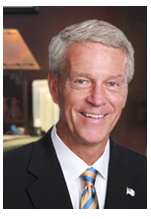 In a Thursday press release, former Tulsa City Councilor Bill Christiansen, the only announced candidate for next year's mayoral election, announced his opposition to the Vision2 Tulsa County sales tax scheme on the November 6, 2012, ballot.
In a Thursday press release, former Tulsa City Councilor Bill Christiansen, the only announced candidate for next year's mayoral election, announced his opposition to the Vision2 Tulsa County sales tax scheme on the November 6, 2012, ballot.
In his statement, Christiansen, who served on the Dialog/Visioning Task Force Steering Committee that assembled the Vision 2025 plan in 2003, contrasts the lengthy process that led to Vision 2025's list of projects to the hastily and haphazardly assembled Vision2 grab-bag.
Christiansen rightly characterizes the public meetings on Vision2: "The five Vision2 meetings consisted of people who wanted money for their project or people who were against the proposals all together." He calls for a focus on meeting our essential needs first and then talking about how to prioritize the "nice to have" items.
Christiansen's statement in full:
The citizens of Tulsa have before them a new $748.8 million Vision2 Plan that contains two propositions for the voters to consider on November 6th. The Vision2 Plan has an "Economic Development" portion and a "Quality of Life" portion, with each part approximately the same size. The sponsors of the proposal have had an input period of roughly two months to hear one-way public comment on the "Quality of Life" issues only.I attended all the public Vision2 meetings and was amazed to see the process moving forward so quickly, especially considering the staggering financial size of the issues and the far reaching ramifications of the projects themselves. As a member of the Vision 2025 leadership team, we spent over a year taking public input and having public discussion with complete transparency and openness of what that vision entailed. On election day, all citizens of Tulsa County knew exactly what they were voting for. Vision2 is considerably larger and is being pushed through the process without open discussion and one-on-one dialog with their elected officials. The five Vision2 meetings consisted of people who wanted money for their project or people who were against the proposals all together. Many of the projects are worthy, but when you get into the details, many are things that would be nice to have rather than the essential needs of our citizens.
I am not against exploring the needs of the city. I am not against these proposed projects. I am for focusing on our immediate needs. Once those needs are met, let's prioritize our "wants". We need to focus on repairing and widening our streets and making certain public safety is funded properly so all Tulsans can feel safe in their city.
This process deserves the same level of analysis we did with Vision 2025. There is no need to rush these Vision2 projects. I believe we need to hold on this Vision2 proposal and believe we can accomplish a better vision for our future.
We have the time to do it right, we won't have the chance to do it over.
